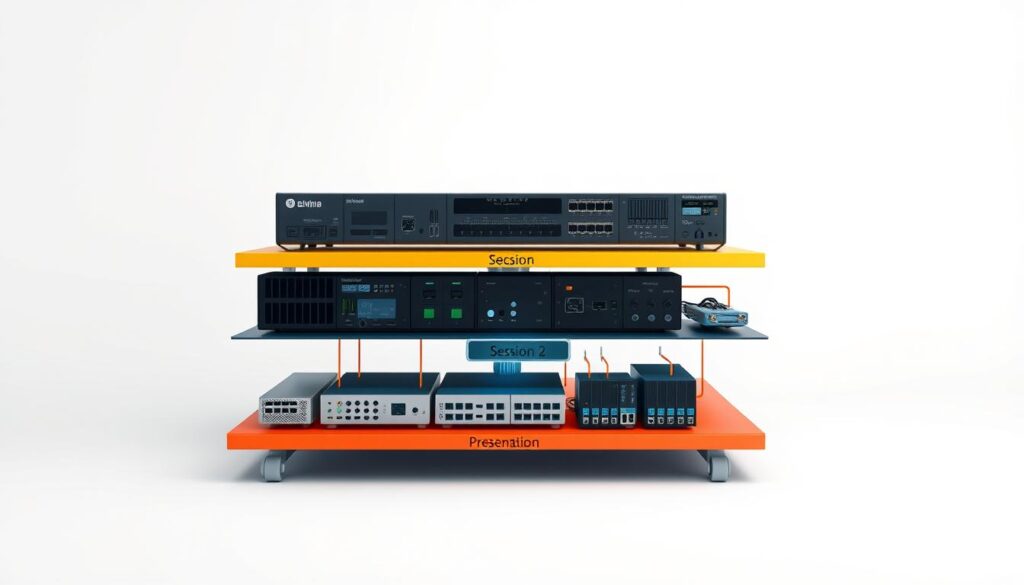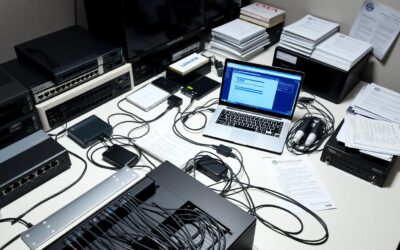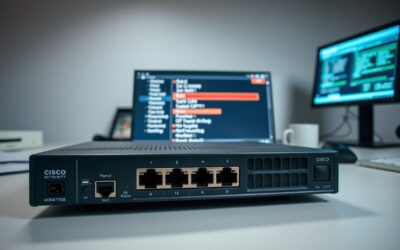Imagine sitting down with your morning coffee while we unpack one of networking’s most powerful tools. This guide will simplify how devices communicate across networks, giving you the clarity needed to tackle CCNA exams or real-world troubleshooting. Let’s turn complex concepts into actionable knowledge you can apply immediately.
Since its standardization in the 1980s, this layered framework has acted as a universal language for network professionals. By breaking communication into seven distinct stages, it transforms chaotic issues into manageable tasks. Think of it like a postal service: data gets wrapped, addressed, and delivered step-by-step across different “departments.”
Why does this matter for your career? Whether you’re diagnosing a slow connection or configuring firewalls, understanding each layer’s role helps pinpoint problems faster. Tools like Wireshark even mirror this structure, showing how data moves from physical cables to user-facing apps. You’ll walk away knowing how to isolate glitches and optimize systems with confidence.
Key Takeaways
- The framework divides network communication into seven specialized layers for easier analysis.
- It serves as a universal troubleshooting tool, adopted as an industry standard since 1984.
- Each layer handles specific tasks, similar to how mail passes through sorting facilities.
- Data encapsulation ensures seamless transmission between devices and applications.
- Mastering this concept is critical for CCNA certification and real-world network management.
Introduction: Tackling Networking Challenges with the OSI Model Guide
Ever stared at a router, wondering why your video call keeps freezing? You’re not alone. Network glitches feel like solving a puzzle with missing pieces—until you learn the open systems interconnection approach. This framework organizes data flow into seven specialized tiers, acting like a troubleshooting GPS for engineers.
Think of it as a team effort: each layer handles unique tasks. Physical cables connect devices (Layer 1), while protocols like IP manage addressing higher up (Layer 3). Studies show teams using this method fix issues 40% faster by isolating problems—like spotting a faulty Ethernet port instead of blaming the entire network.
| Layer Number | Focus Area | Common Issues Solved |
|---|---|---|
| 1-2 | Hardware & Local Connections | Broken cables, MAC conflicts |
| 3-4 | Routing & Reliability | IP errors, data loss |
| 5-7 | User Experience | Slow apps, encryption failures |
Why does this matter? When your Zoom meeting drops, you could waste hours guessing. But knowing the layers osi model structure helps you check Wi-Fi signals (Layer 1) first, then firewall rules (Layer 7). It’s like having a map for the digital wilderness.
Ready to turn confusion into clarity? Let’s explore how this universal language simplifies communication between devices—and transforms you into a network detective.
Core Principles and Historical Context of the OSI Model
Picture this: It’s 1984, and computer networks speak dozens of incompatible dialects. Engineers waste hours translating between IBM systems, DEC machines, and government protocols. Then came a breakthrough—the open systems approach that changed everything. This framework didn’t just organize network tasks; it built bridges between competing technologies.
How Did This Framework Become a Universal Standard?
The International Organization for Standardization (ISO) cracked the code in 1984. Major tech players quickly adopted the seven-layer structure because it solved a critical problem: chaotic communication. Imagine trying to assemble IKEA furniture without instructions—that’s what pre-standardization networking felt like. The layers osi concept gave everyone the same blueprint.
Early networks struggled with basic tasks. A printer from Company A couldn’t talk to a server from Company B. The new standard’s systems interconnection philosophy fixed this by defining clear handoffs between layers. Suddenly, devices could collaborate like orchestra sections following the same score.
Understanding Modular Design for Effective Troubleshooting
Here’s why modularity matters: When your Wi-Fi acts up today, you don’t blame the entire network. You check the data link layer for MAC address conflicts or verify physical cables (Layer 1). This divide-and-conquer strategy came directly from the 1984 design.
Think of the data link layer as a quality inspector. It uses media access control to ensure error-free delivery—like a bouncer checking IDs before letting data into the network club. By isolating functions, engineers can upgrade security at Layer 7 without disrupting routing in Layer 3.
This historical context isn’t just trivia. It’s why you can troubleshoot a VPN issue faster than engineers could reboot systems in 1983. The past built the ladder you’re climbing today.
Detailed Breakdown of the Seven Layers of the OSI Model
Let’s explore how digital messages travel from your keyboard to a colleague’s screen across the globe. Picture each layer as a floor in a skyscraper—starting with concrete foundations (hardware) and rising to sleek offices (apps). This design lets you fix elevator issues without disrupting the penthouse party.
From Physical Connections to User Applications
At the base, Layer 1 handles raw electrical signals through cables or Wi-Fi waves. Ever snapped an Ethernet plug into a router? That’s Layer 1 in action. Moving up, Layer 2 (data link) uses MAC addresses like apartment numbers to direct local traffic. Switches here prevent your smart fridge from hijacking Zoom calls.
Layer 3 (network) is the GPS of the system—IP addresses route data across cities or continents. When you stream a show, routers here choose the fastest path. Layer 4 (transport) then chops your movie into TCP packets, ensuring no pixel gets lost in transit.
Key Protocols and Their Strategic Functions
Higher layers focus on user experience. Layer 5 (session) acts as a stage manager, opening/closing connections between apps. Layer 6 (presentation) encrypts data like a secret handshake—HTTPS and JPEG compression live here. Finally, Layer 7 (application) is your browser’s playground, where HTTP fetches cat videos and SMTP sends memes to coworkers.
| Layer Number | Common Protocols | Key Functions |
|---|---|---|
| 7 | HTTP, SMTP | User app interactions |
| 6 | SSL, JPEG | Encryption & compression |
| 5 | NetBIOS, RPC | Session management |
| 4 | TCP, UDP | Reliable data delivery |
| 3 | IP, ICMP | Routing & addressing |
This modular setup means you can troubleshoot VPN errors at Layer 3 while ignoring printer jams at Layer 1. Like a well-trained team, each layer focuses on its specialty—no stepping on toes.
Understanding the Data Link Layer and Media Access Control
Picture your office Wi-Fi during a Monday morning rush. Ten laptops, three printers, and a dozen phones all fighting for airtime. The data link layer acts like a traffic cop here, organizing chaos into orderly lanes. It’s where raw signals become reliable messages, ensuring your spreadsheet reaches accounting without errors.
What Makes This Layer Crucial for Network Accuracy?
Think of the link layer as your network’s quality control team. It wraps data into neat frames—like sealing letters in envelopes—and adds error-checking codes. If a frame gets damaged during transit (say, from a frayed cable), CRC checks catch it instantly. No more guessing why half your file vanished mid-transfer.
Exploring the Role of Media Access Control
Ever seen two people talk over each other in a meeting? Media access control prevents that digitally. Protocols like CSMA/CD (used in Ethernet) make devices “listen” before transmitting. It’s why your desk phone doesn’t clash with the conference room projector—each waits its turn on the shared network highway.
| Function | Technology Example | Real-World Impact |
|---|---|---|
| Frame Organization | Ethernet | Prevents data corruption |
| Collision Avoidance | Wi-Fi (CSMA/CA) | Reduces network timeouts |
| Device Identification | MAC Addresses | Blocks unauthorized access |
MAC addresses work like employee badges here. The first three digits identify the manufacturer (Intel vs. Cisco), while the rest are unique to your device. ARP quietly maps these to IP addresses behind the scenes—no manual spreadsheets needed.
Next time your video call stutters, check Layer 2 first. A quick MAC address scan might reveal a rogue smart thermostat hogging bandwidth. Fix that, and you’re the office hero before coffee break ends.
Exploring the Transport and Network Layers in Depth
Ever wonder how your video call stays smooth while downloading files? The magic happens in the transport layer and network layer. These digital traffic controllers ensure your data arrives intact and takes the fastest route possible.
Reliable Data Transmission Through TCP and UDP
Imagine mailing a puzzle piece by piece. TCP acts like a meticulous postmaster—it numbers each piece, confirms delivery, and resends lost fragments. UDP? It’s the speedy courier tossing envelopes into mailboxes without checking. Video streams use UDP because a dropped frame matters less than lag.
| Protocol | Function | Real-World Use |
|---|---|---|
| TCP | Error-checking & retransmission | Web pages, file downloads |
| UDP | Fast, connectionless transfer | Live streams, VoIP calls |
Port numbers are the secret sauce here. Your Zoom uses port 8801, while Chrome grabs 443. This keeps data streams from colliding like separate subway lines.
Routing and Addressing: The Backbone of Network Communication
The network layer works like GPS for data packets. IPv4 addresses act as street numbers, while routers serve as traffic lights directing 18-wheelers (large files) and scooters (emails) through digital cities.
When your Netflix buffers, check these layers first. Verify IP addresses aren’t duplicated (like two houses with same number). Use tracert commands to spot routing bottlenecks—it’s like finding potholes on your data highway.
Pro tip: Always check firewall settings if Layer 4 ports get blocked. It’s often quicker than reconfiguring entire networks. Master these layers, and you’ll fix issues before users hit “refresh.”
Insight into the Session and Presentation Layers
Ever organized a surprise party where timing and secrecy are key? That’s what happens behind the scenes when your devices communicate. Two unsung heroes—the presentation layer and session layer—work like party planners to ensure smooth, secure interactions between apps.

The Art of Digital Translation
The presentation layer acts as a multilingual interpreter. It converts data into formats your applications understand—like translating JPEGs into viewable images or encrypting passwords with AES. Think of it as a secret handshake: data gets scrambled using SSL/TLS protocols before traveling across networks, then decoded safely at its destination.
Here’s why this matters: When you log into your bank’s app, this layer encrypts your details into unreadable code. Even if hackers intercept it, they’ll see gibberish instead of account numbers.
Mastering the Rhythm of Connections
The session layer works like a conference coordinator. It sets up Zoom calls by establishing connections, manages screen-sharing permissions, and ends meetings cleanly. Ever hit “reconnect” after Wi-Fi drops? This layer resumes sessions right where you left off—no need to restart downloads.
| Layer | Key Task | Real-World Example |
|---|---|---|
| Presentation | Data Encryption | HTTPS website security |
| Session | Connection Recovery | Resuming interrupted file transfers |
Together, these layers ensure your Netflix binge stays buffer-free and your work files sync seamlessly. They’re the reason you can switch between apps without losing progress—quietly turning tech chaos into organized harmony.
Navigating the Application Layer and End-User Interactions
When you send a text or refresh a webpage, you’re shaking hands with the application layer. This top tier turns invisible data streams into actions you see and use daily. It’s where your clicks become results—like magic, but with more code.
How Daily Tasks Rely on Hidden Helpers
Think about your last email. SMTP protocols whisked it from your outbox to the recipient’s inbox, while DNS translated “gmail.com” into a machine-friendly address. Even loading this page used HTTP to fetch text, images, and videos—all coordinated silently by the application layer.
| Protocol | Everyday Use | Key Role |
|---|---|---|
| HTTP/HTTPS | Web browsing | Secures data transfers |
| SMTP | Sending emails | Routes messages |
| FTP | File sharing | Manages uploads/downloads |
| DNS | Website access | Translates domains to IPs |
Ever had a video call freeze? That’s the application layer flagging a problem. Maybe a firewall blocked RTP packets, or incorrect port settings disrupted data flow. These hiccups remind us how much we rely on unseen protocols.
Keep your digital life smooth: update apps regularly to patch security gaps, and avoid public Wi-Fi for sensitive tasks. When your email won’t send, check SMTP server settings first—it’s often quicker than rebuilding your entire setup.
Real-World CCNA Applications: Bridging Theory and Practice
Let me share a story about a network meltdown I once fixed at a coffee shop chain. Their payment systems kept dropping connections during lunch rushes. Sound familiar? This is where textbook networking concepts become survival skills.

When VLANs Go Rogue
You’re handed a ticket: “Wi-Fi slow in store #42.” First, you check Layer 1—are antennas properly positioned? Then Layer 2: MAC address tables show 300+ devices fighting for bandwidth. The fix? Creating separate VLANs for POS systems and customer traffic. Suddenly, credit card transactions flow smoothly while teens binge TikTok.
Trust Built Through Shared Struggles
Last month, a hospital’s patient monitoring network started glitching during night shifts. By methodically testing each layer, we found Layer 3 routing errors caused by outdated subnet masks. Updating the configurations restored critical services within hours.
| Troubleshooting Step | Layer Involved | Tool Used |
|---|---|---|
| Signal strength test | Physical | Wi-Fi analyzer |
| Port security check | Data Link | Switch CLI |
| Routing table audit | Network | Ping/Traceroute |
These experiences teach a vital lesson: understanding network functions lets you predict failures before they happen. Like knowing a car’s engine helps diagnose strange noises. Continuous development of these skills turns you from firefighter to architect—building resilient systems rather than just patching leaks.
Deep Dive into the OSI Model Guide Best Practices
Imagine your network as a high-security facility—every door needs unique credentials, and suspicious packages get scanned twice. Modern threats demand this level of vigilance. Let’s explore how to fortify your systems using battle-tested strategies that balance protection with performance.
Building Digital Fort Knox
Start with access control at every layer. Firewalls (Layer 4) filter traffic like bouncers checking IDs, while TLS 1.3 encrypts data transfers (Layer 6) with military-grade algorithms. A 2023 study found organizations using multi-layered defenses reduced breaches by 68% compared to single-point solutions.
Here’s your action plan:
- Deploy web application firewalls to inspect HTTP traffic
- Use API gateways to validate requests before they reach servers
- Segment networks using VLANs to contain potential threats
Future-Proofing Through Smart Design
Optimize packet flow by analyzing traffic patterns. Tools like QoS prioritize video calls over file downloads during peak hours. Cloud-based systems benefit from DEFLATE compression—reducing data loads by 70% without losing critical details.
| Layer Focus | Optimization Technique | Impact |
|---|---|---|
| Data Link | MAC filtering | Blocks unauthorized devices |
| Network | SD-WAN routing | Slash latency by 40% |
| Application | HTTP/3 adoption | Boosts page load speed |
Regularly test your defenses with penetration simulations. One hospital avoided a ransomware attack by patching vulnerabilities found during quarterly audits. Your turn: Which weak link will you reinforce first?
Comparing OSI and TCP/IP: Which Model Fits Your Network?
Ever been stuck choosing between a detailed map and a quick-start guide? That’s the core dilemma when picking frameworks for your network. The seven-layer approach offers precision, while the TCP model prioritizes speed. Let’s break down which one aligns with your goals—whether you’re building a secure enterprise system or optimizing a gaming setup.
What Are the Key Differences in Layer Structure?
The TCP model collapses multiple layers into broader categories. Where the original framework separates presentation and session tasks, this streamlined version bundles them under a single application layer. Think of it like merging departments in a company: faster decisions but less specialized oversight.
| OSI Structure | TCP/IP Equivalent | Key Change |
|---|---|---|
| Layers 5-7 | Application Layer | Combined functions |
| Layer 4 | Transport Layer | Same focus |
| Layers 1-2 | Network Access | Hardware merged |
This consolidation speeds up communication but can blur error sources. If your video chat stutters, is it an encryption issue (Layer 6) or a faulty protocol handshake (Layer 5)? The seven-layer map gives clearer clues.
How Do These Models Impact Network Security and Performance?
Security teams love granular control. Isolating encryption to Layer 6 lets them patch vulnerabilities without touching routing rules. But the TCP model’s simplicity shines in high-speed environments—streaming services use its lean structure to minimize lag.
- OSI Advantage: Pinpoint firewall rules at specific layers
- TCP/IP Strength: Faster data flow with fewer handoffs
Need to prioritize reliability? TCP’s error-checking ensures every packet arrives—perfect for banking apps. Prefer speed? UDP in the TCP model skips confirmations, ideal for live gaming. Your choice depends on what’s louder: the clock ticking or auditors knocking.
Conclusion
Think back to your last network hiccup—maybe a dropped video call or slow file transfer. Every layer we’ve explored plays a role in those moments. From copper cables at the physical layer to encrypted app interactions, this framework turns chaos into solvable puzzles.
You’ve seen how data transforms as it climbs through layers: raw signals become frames, then packets, finally landing as emails or streaming videos. Each tier adds unique value—like error-checking in the link layer or session recovery higher up. These concepts aren’t textbook relics; they’re your toolkit for modern network challenges.
Start applying this knowledge today. Check physical connections before blaming software. Use layered security—firewalls at the transport level, encryption in the presentation tier. Monitor packet flows to spot bottlenecks early.
Keep learning through hands-on practice. Test VLAN configurations. Experiment with Wireshark filters. Every skill you build makes communication systems more reliable. Now go fix something—you’ve got this.
FAQ
How did the OSI model become a universal standard?
Why is modular design important for troubleshooting?
What’s the difference between the physical and application layers?
What makes the data link layer crucial for network accuracy?
How does media access control manage device communication?
How do TCP and UDP ensure reliable data transmission?
Why are data translation and encryption vital in networking?
Which application protocols do you use daily without realizing?
How do layered security measures protect modern networks?
What are the key differences between OSI and TCP/IP models?
Source Links
- Introduction to the OSI Model
- CCNA Tutorials 2: OSI Model and Layers
- OSI Model Explained: The 7 Layers Every Networking Pro Must Know | TRG Datacenters
- What is the OSI model? The 7 layers of OSI explained
- The OSI Model: A Comprehensive Guide to Network Communications
- OSI model
- OSI Reference Model and its Importance
- What is OSI Model | 7 Layers Explained | Imperva
- What is the OSI Model? – 7 OSI Layers Explained – AWS
- 7 Layers Explained: OSI Model Guide
- The Ultimate Guide to OSI Model: Physical and Data Link Layers Explained
- Data-Link Layer In The OSI Model: Working and Implementation | Simplilearn
- Understanding the OSI Model: A Detailed Guide
- OSI Model: The 7 Layers of Network Architecture
- Network Layers Explained: OSI & TCP/IP Models [with examples]
- Understanding the OSI Model – N10-008 CompTIA Network+ : 1.1 – Professor Messer IT Certification Training Courses
- A Practical Guide to Network Communication
- A Comprehensive Guide for Aspiring Programmers – AlgoCademy Blog
- What Is the OSI Model? | IBM
- Understanding the Application Layer of the OSI Model
- Simplifying IT: A Guide to Navigating Digital Changes with the OSI Model
- Mastering the Path to CCNA: A Comprehensive Guide for Network Professionals
- CCNA 200-301 Version 1.1 Video Course, 2nd Edition
- CCNA 200-301 Version 1.1 Video Course, Second Edition
- The Presentation Layer of the OSI Model: An In-Depth Guide for Professionals
- Unlocking the OSI Model: A Deep Dive into Digital Communication Foundations
- TCP/IP Model vs. OSI Model: Similarities and Differences | Fortinet
- TCP/IP vs. OSI: What’s the Difference Between them?
- The OSI Model | Codecademy
- Demystifying the OSI Model: A Beginner’s Guide to Understanding Computer Networking Layers
- The Ultimate Guide to the OSI Model: A Deep Dive into the 7 Layers of Networking





